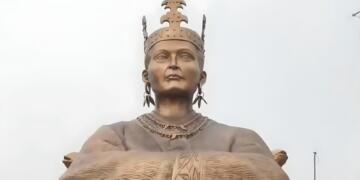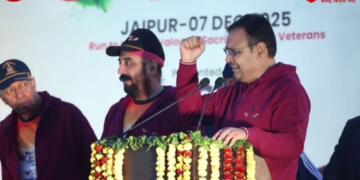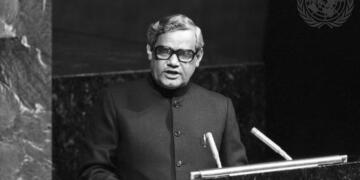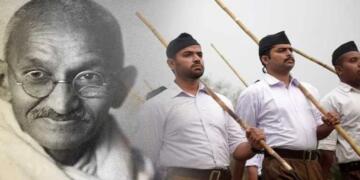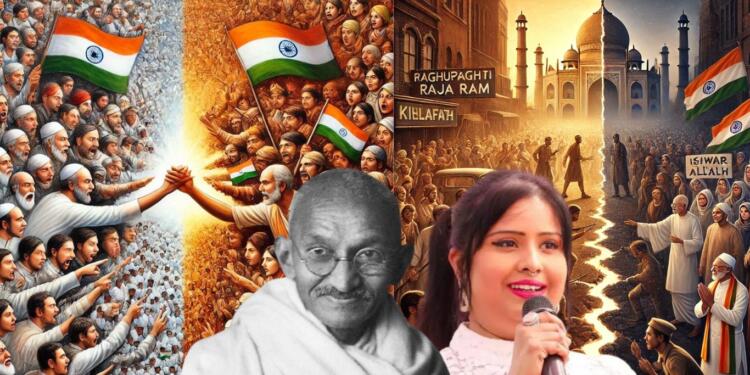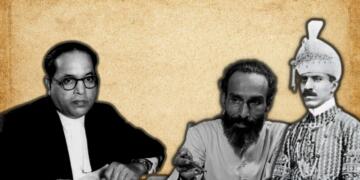In one of his speeches as Bharatiya Janata Party (BJP) spokesperson, Sudhanshu Trivedi rightly observed that truth can’t be hidden; it finds a way to emerge from even the last rubble of demolition.
The wave of decolonisation set forth in the last few years is just beginning to manifest that truth. One of the incidents eligible to be termed as a trademark of this very fundamental feature of decolonisation recently took place in Bihar, and incidentally on the birthday of Atal Bihari Vajpayee.
A Bhojpuri singer named Devi was invited to sing on the Birth Anniversary by senior BJP leaders. Things were going fine until she decided to sing a song made famous by Mohandas Karamchand Gandhi and later Bollywood. The lyrics go something like this:
“Raghupati Raghav Raja Ram,
Patit Pavan Sita Ram.
‘Ishwar Allah Tero Naam,
Sabko Sanmati De Bhagwan.“
Devi was just singing it out of habit of doing it at every good occasion. She had no idea that the audience was enlightened about the song. What she tried to sing is an altered version of a famous song by Pandit Laxmanacharya, the original lyrics of which are:
“Raghupati Raghav Raja Ram,
Patit Pavan Sita Ram.
Sundar Vigrah Meghashyam,
Ganga, Tulsi, Shaligram.”
The audience was aware of the full issue and it did not go down well with Devi. She was asked to apologise, to which she obliged, but the audience kept leaving the show. Senior BJP leader Ashwini Choubey even chanted Jai Shri Ram from the mic to calm them, but those who decided to leave did so without any fluster.
As usual, opposition leaders like Lalu Yadav, his son Tejashwi Yadav, their alliance partner Congress leaders, and the troll army dedicated to them decided to milk this opportunity and paint BJP as anti-women and anti-Gandhi.
The thing is, they are missing a point of factual importance here. It was not BJP members who were outraged, it was the audience, and hence criticising them makes neither logical nor political sense. One can’t keep teaching old books to someone and expect that they won’t point out falsehoods.
Beneath this small outrage in some obscure location of India lies the volcano of something big transcending across the nation. This phenomenon is the hunt for reality in the fading art of reading books and consuming information through new means like podcasts, YouTube videos, and feature movies.
The most tragic reality which people proud (more than 80 percent) of the Indian independence movement have to face nowadays is how outright lies were spread through various communication channels. Case in point is the song sung by Devi.
Apparently, an investigation into why there was a need to compose these songs exposes the narrative of the independence movement being directed towards a single goal of attaining political independence. The fact of the matter is that the outcome of the movement was not meant as equality for everyone – no matter how much the Constitution written in the aftermath says about it.
Different groups having different ideas about sending out the Britishers were used under one big umbrella for the cause. Zamindars miffed with the Britishers wanted their land rights back, kings made subservient to British suzerainty feared losing their sovereignty, scheduled castes wanted freedom from the aforementioned three categories of friends and foes, while Scheduled tribes just wanted to be left alone.
All of these demands had one thing in common, and that is the seriously inert nature of these demands. Nowhere did these people join the movement for something or someone located thousands of miles away from Indian territory. In that context, the assimilation of various Muslim groups in the freedom fold betrays the nature of the movement itself.
After 1857, there were attempts to include the Muslim community in the movement and individual leaders, in fact, did, but it was never a concerted effort on the part of the community until they were assimilated under the non-cooperation movement. To put it bluntly, Muslim nationalists (popularly known as proponents of Ummah) dominated over nationalist Muslims in the decades between 1857 and 1920, possibly because Mughal rule was done and dusted by the Britishers.
The Britishers had thought of the void as a perfect opportunity to play divide and rule. Gandhi saw it through his experiences in South Africa. He wanted to convert the independence movement into a coordinated effort of Muslims and Hindus. The opportunity was provided by the Britishers themselves as they went to accelerate the Ottoman Empire’s decline.
The Ottoman Empire had aligned with the Central Powers in World War I and faced a significant military defeat. Later, the Treaty of Versailles in 1919 curtailed its territorial reach and political power. European victors – led by the Britishers and American money – pledged to uphold the Ottoman Sultan’s position as caliph.
However, the Treaty of Sèvres in 1920 further dismantled the empire by stripping it of territories like Palestine, Syria, Lebanon, and Iraq.
The Ottoman Sultan was nominally the supreme religious and political leader of Sunni Muslims. Dismantling him caused discontentment among Indian Muslims – the majority of whom were (and are too) Sunni.
Gandhi and Congress found it to be a common ground of enmity (Gandhi wouldn’t like this word) towards the British between Muslims and the rest of Indians. The formula is simple: “Enemy’s enemy is a friend.” Gandhi and co. advertised that the fall of the Ottoman Empire was part of eliminating local culture and sovereignty on the part of European powers (read British). The position was that the Khilafat movement was not just about Muslim interests but also about securing the rights of all Indians.
In essence, he secularised the Khilafat movement by assimilating it into the non-cooperation movement. Historians have not written about the psyche of the average person protesting on the road against colonial power. The secularisation of the Khilafat movement or Islamisation of the non-cooperation movement begs a few questions.
Whether an average Muslim was on the road feeling that his/her attempt may result in the Britishers leaving the territory in which he/she resided or was it about Turkey?
Whether a non-Muslim on the road thought that he was contributing to a movement which had the potential to reinstate the centuries-old Ottoman Empire? What if the Britishers accepted this demand but didn’t give India independence?
The answer to both these questions can only be provided through time travel, which is not a possibility by the time I am writing this. Moplah riots and blasphemy-related killings do provide clues for those who want to see the reality.
Gandhi and Congress gathered quite a lot of appreciation for their efforts at unification, which was frankly next to impossible because of the virtues prescribed to followers of both religions. One pitches for expansion through peaceful and non-peaceful means, while the other just allows and welcomes everyone in its fold.
Gandhi knew it, and so did he begin his community outreach through various programmes where people from both communities. He wished to establish what we now know as Ganga-Jamuni tehzeeb. Even that slogan sanctifies the appropriation of India’s indigenous Yamuna river by pre-Britisher Arab, Turkic, and Mongol colonisers.
Gandhi’s attempts were destined to fail, and it eventually met its inevitable downfall after the failure of the Quit India movement. Those who could predict it died with the guilt of not being able to save thousands of lives (mostly Hindus) due to the bloodshed it caused.
Anyone having witnessed this horror in the name of religion would be happier with Muslim nationalists taking all Muslims with them to Pakistan. But again, Gandhi prevented a lot of them from crossing the border, making the fading sentiment of turning India into a European model secular country a bit louder and a legitimate demand.
Following him, India did its best on the secular front. It used the song given by Gandhi in popular culture. Movies used it for creating a sense of religious harmony and also used it on pious occasions. The country made separate provisions for Muslims in its constitution and a separate standard of justice, which incidentally in many ways goes against their own Shariat Law, but is more liberal, so it finds acceptance.
Also Read: Crusade, Conversion, Colonialism have shaped Christianity’s spread
India romanticised poisonous songs like Chhap Tilak Sab Cheeni Re and Hum Dekhenge songs, among others. It also gave proper respect to Allama Iqbal for writing Saare Jahan Se Accha, even though he played a crucial role in the religion-based bifurcation of India and later became the national poet of Pakistan.
In the process, the majority voice behind the independence movement subsided and kept giving space until it was pushed to the brink. Through popular media platforms and advertisements, Hindus witnessed their religious celebrations getting Abrahamicised and could not bear it after a certain extent.
Before the appropriation project could kick off, the internet revolution came to India, and every piece of information hidden from history textbooks became mainstream knowledge. The twisted lyrics and poisonous meanings of songs behind soothing music are no longer a far-right conspiracy, and are working as a catalyst for the resuscitation of the civilisational voice.
Chroniclers are finally accepting that revolutions and movements are not the ultimate solution, as most of them fail to provide a credible answer to the “what after that” question. But there have been a few resolutions which have been largely successful—the biggest of whom is the American revolution.
What made it successful were two common features—common identities and common economic goals. The diversity of different communities coming together under one umbrella was never its biggest strength. Even today, whenever the balance tilts in the opposite direction (of harmonisation of religious and ethnic identities), the electoral pendulum quickly switches in a white nationalist and Judeo-Christian direction.
No one could envision in 1786 that this would be the reality in 2024—238 years after the revolution.
On the contrary, we have examples like the French and Russian revolutions, where various sections had a common enemy, but not a common idea on what to do after we obliterated the common enemy.
Unfortunately, the same holds true for the Indian independence movement. It had two irreconcilable communities coming together against a common enemy. Before that common enemy, one community was at the throat of the other and advocated for the destruction of its civilisation.
These kinds of reconciliations are always temporary in nature. Romanticisation of cultural genocide does not work in the long run.





